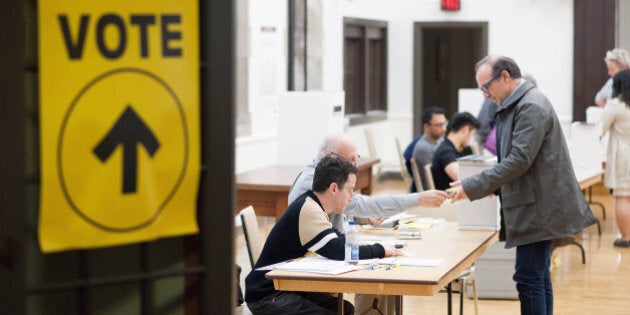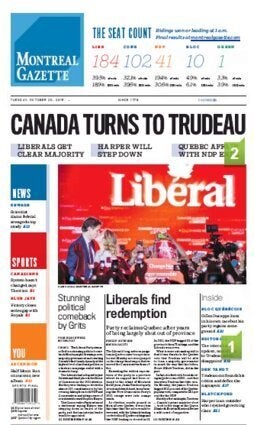
Co-authored by Nicholas Himmelman
Two weeks before the 2015 election, the Conservative war room realized voters are flocking from the NDP to the Liberals. This worried them since they count on vote splitting to enable their candidates to win. A senior Conservative organizer even called the NDP to warn that if they both don't go after the Liberals, they would lose.
What makes such a big shift of support possible?
Thirty per cent of Canadian voters (over 5 million) have little to no partisan attachment [1]. By comparison, only eight per cent of U.S. voters swing their party support, and thus the elections. A large non-partisan voting bloc explains the 2015 shift from orange to red, where in a span of three weeks, 1.4 million voters changed their mind from NDP to Liberal. This provides the perfect environment for strategic voting to swing elections.
A voter who chooses a less-preferred candidate to avoid an undesirable outcome is voting strategically. After four years of a majority Conservative government elected against the will of 61 per cent of Canadians, strategic voters became a major voice in this election, all with a common goal of firing Mr. Harper. Even HBO's John Oliver joined the Anyone But Harper bandwagon:
In the wake of a historic election, many Canadians are wondering if strategic voting lived up to its expectations. Some experts are already saying it did. This deserves a deeper analysis that would impact future elections, not only in Canada but worldwide. We took a quick look at the data and tried to answer four important questions:
1. How well did strategic voting recommendations work?
Leadnow made 29 candidate recommendations, and 24 of them won the election. We made 16 of our own using a different selection method that focused on tougher ridings where Conservatives were leading the polls [2]. Nine of our candidates managed to win as well.
On the flip side, both Leadnow and we backed the wrong progressive candidate in a total of five ridings (out of 43). The narrowest Conservative victory in this group came down to 2,600 votes (4.9 per cent). Leadnow had gathered 600 pledgers in that riding.
It is hard to find out exactly how many votes were cast strategically in each riding. Nationwide, in 22 ridings the margin of victory was less than 1.5 per cent. Leadnow backed candidates in three of those ridings (two NDP and one Liberal). In two ridings, they clearly had enough pledged voters to make a difference.
In our recommended ridings, three candidates won by fewer than 1,900 votes (all Liberal). Overall, the shift of support in Liberal ridings we targeted exceeded the national average by about 2.5 per cent (or roughly 1,400 votes) -- though this estimate misses on a potentially larger nation-wide strategic trend, as we will discuss below.
All considered, there is a clear possibility that six ridings were won thanks to merely 5,900 strategic voters. That means 0.03 per cent of all voters were responsible for two per cent of the elected seats. But was there potentially a larger nation-wide impact by strategic voting campaigns?
2. How many strategic voters were actually out there?
Due to a high level of public awareness, a larger impact of strategic voting education may be hiding in overall national trends. For example, the last minute decision by 1.4 million voters to switch from NDP to Liberal may in part be due to their assessment of candidate and party electability.
As CBC's poll analyst Eric Grenier put it: "Polls in the last week showed that the NDP's voters were less committed than those of the Liberals, and Justin Trudeau's party was, by far, the one Canadians expected would win on election night."
Voters who consider candidates' electability as a criteria are acting strategically. Viable candidates are often viewed more favourably. This is why campaigns with plummeting stocks never acknowledge it (see Mr. Mulcair's interviews).
When 5 million non-partisan Canadians make a decision, they consider a host of issues including party platforms, leaders and very often, electability. They may not self-identify as strategic voters, but are nonetheless affected by the perceived candidate viability, and are likely to make an inherently strategic decision.
In this election, websites like votetogether.ca and strategicvoting.ca became popular destinations for assessing electability of local candidates. Using the available local polls and projection models, voters could decide which local candidate had a better chance. Our blog post highlighting 16 key ridings received over 50,000 likes and 350,000 views in less than three days, and Google reported six times more searches about strategic voting in this election than in 2011 or 2008.
3. Was strategic voting necessary?
In 2011, Conservatives received only 240,000 more votes than they did this year, yet that resulted in their majority government. The Conservative's core party loyalists (5.6 million strong) are roughly twice the size of either the Liberals' (2.8 million) and the NDP's (2.5 million), and therefore it takes only a small support from non-partisan voters to tip the balance in their favour. This shows the importance of non-partisan voters.

This year, the Liberals received 80 per cent of the non-partisan vote (over 4 million), contrary to 2011 when NDP received 87 per cent of it (only 2 million, due to lower turnout).
It is difficult to explain this significant shift entirely on party platforms (which analysts agree share many similarities), or party leaders (final Nanos poll put Mr. Trudeau's personal support as prime minister at 36 per cent).
Therefore it is quite possible that the significant non-partisan voter support for the Liberals is in part thanks to many voters acting strategically and selecting the more viable option.
4. Will the Liberals fix our electoral system?
In the summer, Mr. Trudeau laid out his plan to end Canada's first-past-the-post electoral system. In light of the Liberal majority, many are questioning if Mr. Trudeau has enough motivation to deliver on that promise.

Looking at the growing support for NDP and the Green party may provide Liberals with the necessary motivation to act. In the last election, NDP attracted 4.5 million voters. While that number dipped to 3.5 million this year, this is still their second-largest record in history by a large margin.
The NDP's voter base has increased at about four times the rate of the eligible voter growth since 2004. This means that the splitting of progressive votes will continue to get worse.
Mathematically speaking, it is getting increasingly difficult for progressive parties to come to power.
Footnotes:
[1] Looking at the minimum votes received by each party in the last four elections, we can determine a ceiling for each party's voter base. The 5 million non-partisan voter estimate represents those who backed more than one party in the last decade, as well as new voters who have no historic voting bias.
[2] While Leadnow's riding selection was primarily community driven, our strategy was to focus on ridings where Conservatives were leading in polls. On average, our candidates were lagging behind Conservatives by six per cent, whereas Leadnow's community selection method resulted in candidates who were ahead of Conservatives by an average of eight per cent.
MORE ON HUFFPOST:
